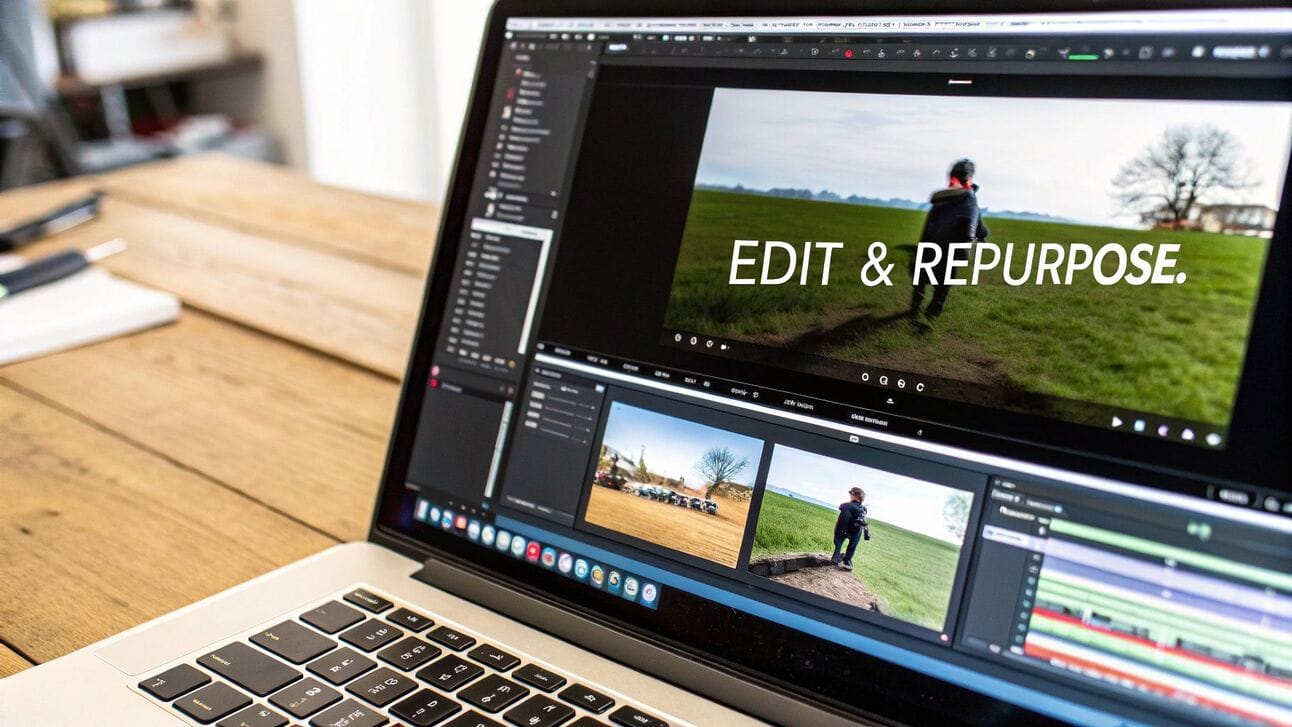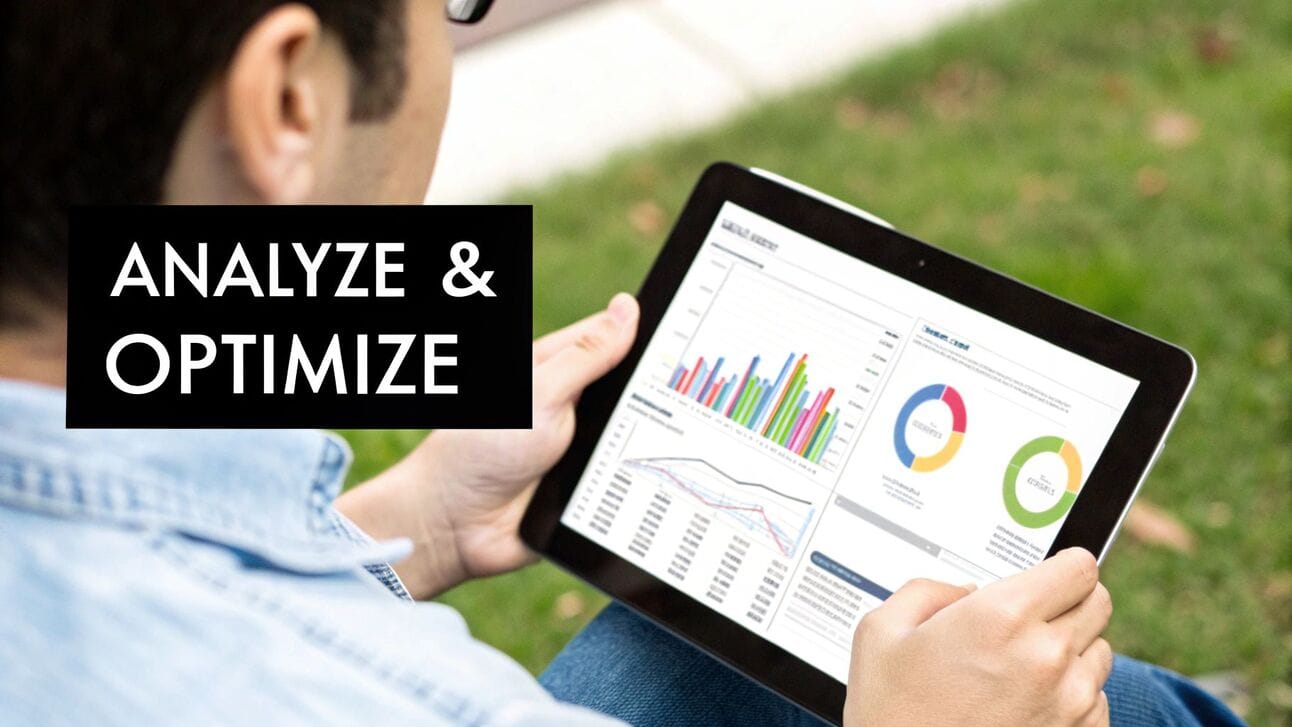- Social Media Growth Guide
- Posts
- How to Repurpose Video Content: A Strategic Guide to Maximizing Your ROI
How to Repurpose Video Content: A Strategic Guide to Maximizing Your ROI
Understanding the Power of Video Content Repurposing

Creating excellent video content is just the first step. The real value comes from video content repurposing - taking your existing videos and adapting them into different formats to reach more people across various platforms. One video can serve as the foundation for multiple pieces of content, helping you share your message with a wider audience.
Consider how a recorded webinar can take on new life: You can create short clips for social media, write detailed blog posts based on the content, or develop an email series sharing key insights. This approach helps you connect with people who prefer to consume information in different ways, whether through text, audio, or video.
The numbers show why this matters: 85% of Americans watch online videos monthly on their devices. Learn more in this detailed breakdown: Learn more about content repurposing statistics. This widespread video consumption shows why it's essential to adapt your content for different platforms and formats. When you repurpose strategically, you can maximize your content's impact while making smart use of your resources.
Adapting to Modern Content Consumption Patterns
The way people watch and interact with video content has changed significantly. Understanding these shifts is essential for effectively reusing video content across different channels. Viewers now prefer quick, digestible content they can consume on-the-go. This means we need smarter approaches to adapt and repurpose video content to reach diverse audiences.
The Rise of Short-Form Video
While long-form videos remain valuable, they don't always match how people consume content today. Platforms like TikTok and Instagram Reels excel with brief, engaging clips that capture attention quickly. Breaking down longer videos into focused segments helps highlight key messages and meets viewers' preferences for shorter content. Data shows that by 2025, 69.8% of top-ranking videos on Google will be long-form, while 30.2% will be short videos under 60 seconds. For more insights, check out this detailed analysis of video content trends.
Tailoring Content to Each Platform
Effective video repurposing goes beyond just trimming length - it requires optimizing for specific platforms. Square videos tend to perform best in Instagram feeds, while vertical formats work well for Stories and TikTok. Each platform has its own style: LinkedIn users expect professional content, while Facebook audiences respond better to casual approaches. Consider each platform's unique requirements for aspects like video dimensions, captions, and overall tone to maximize impact.
Join 400,000+ executives and professionals who trust The AI Report for daily, practical AI updates.
Built for business—not engineers—this newsletter delivers expert prompts, real-world use cases, and decision-ready insights.
No hype. No jargon. Just results.
Strategic Approaches to Content Repurposing

The most effective content repurposing goes beyond just creating short clips from videos. Smart content teams develop clear workflows to maximize the value of each piece of content. By treating videos as foundational assets, you can build an effective system for sharing your message across multiple channels.
Identifying Repurposing Opportunities
Start by selecting the right videos to repurpose. Focus on content that has already proven successful with your audience or covers timeless topics. Review your content calendar to align repurposed pieces with upcoming campaigns and marketing goals. Not every video needs to be transformed into every possible format - be selective about which content to adapt.
Maintaining Brand Consistency Across Formats
When adapting video content for different platforms, keep your brand identity clear and consistent. Your core message, visual style, and tone should remain recognizable whether someone encounters your content on YouTube, Instagram, or LinkedIn. Use consistent branding elements like logos, colors, and fonts across all formats. According to recent data, 94% of marketers currently repurpose their content, showing this is now a standard practice. Find more details here: Explore this topic further. You might be interested in: How to master your content creation process.
Scaling Content Output Without Sacrificing Quality
A solid repurposing system helps you create more content while maintaining high standards. Set up clear processes for selecting, adapting and distributing content across platforms. Create templates and guidelines to help your team work efficiently and consistently. Think of content repurposing like a production line - each step builds on the previous one to create polished final pieces. When done right, this approach turns your videos into valuable assets that drive engagement and deliver results.
Platform-Specific Optimization Techniques

Creating effective video content requires understanding what works best on each social platform. Just like you'd dress differently for different occasions, your videos need to be adapted for each platform's unique environment. Here's how to optimize your repurposed videos for maximum impact.
YouTube and YouTube Shorts
On YouTube, focus on including relevant keywords in titles and descriptions to boost search visibility. For more details, check out this guide on How to master YouTube SEO. While standard YouTube accepts various video lengths, keep Shorts under 60 seconds and include popular audio and captivating visuals.
Instagram Reels and Stories
Instagram users expect visually striking content. Make your Reels stand out with popular music tracks, creative filters, and smooth transitions. For Stories, take a more casual approach - show behind-the-scenes content and use interactive elements like polls to boost engagement. Remember that vertical format works best here.
TikTok
Success on TikTok comes from short, engaging content that catches attention quickly. Use popular sound clips, join trending challenges, and keep your message simple and entertaining. Quick edits, on-screen text, and dynamic visuals are essential for TikTok's fast-paced environment.
Keep it professional on LinkedIn with content focused on industry insights and expertise. Your videos should deliver clear value through tips, news analysis, or thought leadership. Aim for concise videos that respect your audience's time while maintaining professional standards.
Facebook offers flexibility in video formats, working well for both brief clips and longer content. Build community by actively responding to comments and sharing varied content types. Try mixing different approaches like live streams and casual behind-the-scenes footage.
Optimizing for Each Platform: A Summary
Platform | Video Length | Content Style | Key Features |
|---|---|---|---|
YouTube | Variable | Informative/Engaging | Keywords, descriptions |
YouTube Shorts | <60 seconds | Concise/Trending | Trending audio, visuals |
Instagram Reels | Short | Creative/Trending | Music, filters |
Instagram Stories | Short | Casual/Interactive | Polls, questions |
TikTok | Short | Entertaining/Trending | Sounds, challenges |
Short-Medium | Professional/Value-driven | Industry insights | |
Variable | Diverse/Engaging | Live streams, comments |
This overview highlights the key aspects of optimizing video content for each platform. Success comes from understanding each platform's unique culture and adjusting your content accordingly.
Tools and Technologies for Efficient Repurposing
Video repurposing requires strategic use of the right tools to achieve optimal results. In this section, we'll explore essential software and platforms to help you maximize your video content's reach.
AI-Powered Transcription and Captioning
Converting videos into text-based content requires accurate transcription. Tools like Otter.ai and Descript provide AI-powered transcription that can save hours of manual work. These platforms also generate captions - a critical feature since 85% of social media videos are watched without sound.
Video Editing Software
Quality video editing software enables you to create polished content for each platform. Professional tools like Adobe Premiere Pro and Final Cut Pro offer advanced capabilities for high-end production. For those starting out, DaVinci Resolve provides robust features in its free version.
Repurposing Platforms
Dedicated repurposing tools like Repurpose.io help automate content distribution across social media channels. These platforms handle format optimization and posting schedules, reducing the manual effort needed to reach multiple platforms effectively.
Graphic Design Tools
Creating visuals from video content requires user-friendly design software. Canva stands out for its extensive template library and intuitive interface. This makes it simple to produce eye-catching graphics for Instagram, Pinterest, and other visual platforms.
Choosing the Right Tools for Your Needs
Feature | Basic Option | Advanced Option |
|---|---|---|
Transcription | Otter.ai (Free Tier) | Descript |
Video Editing | DaVinci Resolve (Free) | Adobe Premiere Pro |
Repurposing | Manual Uploads | |
Graphic Design | Canva | Adobe Photoshop |
This overview provides starting points for building your video repurposing toolkit. By selecting tools that match your needs and budget, you can create an efficient workflow that expands your content's impact without overwhelming your resources.
Measuring Success and Optimizing Performance
Measuring results and analyzing performance are key steps after repurposing your video content. Looking beyond basic view counts and likes helps understand which content truly connects with your audience. The right performance tracking guides smarter content decisions.
Key Metrics for Repurposed Content
Important performance indicators to monitor include:
Engagement Rate: Measure audience interactions like comments, shares, and saves. High engagement suggests valuable content.
Click-Through Rate: Track how effectively your calls-to-action drive traffic and actions.
Conversion Rate: Evaluate how content supports goals like lead generation and sales.
Long-Term Value: Compare engagement patterns over time. Some content formats deliver quick wins while others provide ongoing benefits.
Performance Tracking Systems
Track metrics across all your content distribution channels using Google Analytics and platform analytics tools. This provides a complete view of how repurposed content performs. For more guidance, check out How to master measuring social media success.
Testing and Optimizing Content
Use A/B testing to improve your content strategy. Test different headlines, thumbnails, and calls-to-action to find what works best. Review audience comments and feedback regularly to understand their preferences. Make adjustments based on these insights to create more effective content over time.
Regular analysis of key metrics and data-driven improvements help maximize the impact of your repurposed videos. This process builds stronger content that achieves your marketing goals.
Start your newsletter & monetize it
If you are serious about starting a newsletter & monetize it to be the master of your time, I highly recommend Beehiiv.


